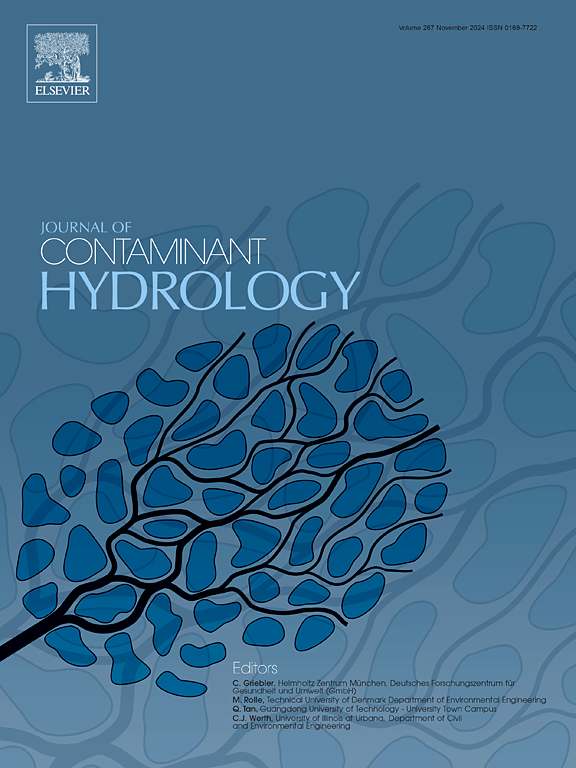Comparing the variable flow velocity advection-dispersion model with the continuous time random walk model: Insights from a soil column salt transport experiment
IF 4.4
3区 环境科学与生态学
Q2 ENVIRONMENTAL SCIENCES
引用次数: 0
Abstract
The transport of salt in low-permeability media can significantly alter permeability. To investigate the impact of permeability changes on solute transport simulations, this study conducted a salt transport experiment using a soil column with an upper sand layer, a middle clayey silt layer, and a lower sand layer. The experimental results showed that, under a constant hydraulic head difference, the flow rate decreased linearly, with a reduction exceeding 35 %. The solute penetration time increased significantly along the flow path. Using the velocity decay data, an advection-dispersion model that accounts for variations in flow velocity was developed. Additionally, an advection-dispersion model with constant flow velocity and a continuous time random walk (CTRW) model were also developed, both of which ignored velocity changes. Simulation results indicated that the variable flow velocity advection-dispersion model yielded the best results, followed by the CTRW model, with the constant flow velocity advection-dispersion model performing least effectively. When measured data on flow velocity changes are available, the variable flow velocity advection-dispersion model is recommended. If measured velocity change data are unavailable but the range of CTRW model parameters can be ascertained, the CTRW model is advisable. In the absence of ascertainable CTRW model parameter ranges and when the constant flow velocity advection-dispersion model is necessary, the advection-dispersion model with a constant maximum flow velocity should be employed.
变流速平流-弥散模型与连续时间随机游走模型的比较:来自土壤柱盐运移实验的启示。
盐在低渗透介质中的运移会显著改变渗透率。为了研究渗透性变化对溶质运移模拟的影响,本研究采用上部砂层、中部粘土粉砂层和下部砂层的土柱进行了盐运移实验。实验结果表明,在水头差一定的情况下,流量呈线性下降,降幅超过35%。溶质穿透时间沿流道显著增加。利用速度衰减数据,建立了考虑流速变化的平流-弥散模型。此外,还建立了恒定流速下的平流-弥散模型和连续时间随机游动(CTRW)模型,两者都忽略了流速的变化。结果表明,变流速平流-弥散模型效果最好,CTRW模型次之,恒流速平流-弥散模型效果最差。当有流速变化的实测数据时,建议采用变流速平流-弥散模型。如果没有实际的速度变化数据,但可以确定CTRW模型参数的取值范围,则建议采用CTRW模型。在不能确定CTRW模型参数范围的情况下,当必须采用恒流速平流-弥散模型时,应采用恒最大流速平流-弥散模型。
本文章由计算机程序翻译,如有差异,请以英文原文为准。
求助全文
约1分钟内获得全文
求助全文
来源期刊

Journal of contaminant hydrology
环境科学-地球科学综合
CiteScore
6.80
自引率
2.80%
发文量
129
审稿时长
68 days
期刊介绍:
The Journal of Contaminant Hydrology is an international journal publishing scientific articles pertaining to the contamination of subsurface water resources. Emphasis is placed on investigations of the physical, chemical, and biological processes influencing the behavior and fate of organic and inorganic contaminants in the unsaturated (vadose) and saturated (groundwater) zones, as well as at groundwater-surface water interfaces. The ecological impacts of contaminants transported both from and to aquifers are of interest. Articles on contamination of surface water only, without a link to groundwater, are out of the scope. Broad latitude is allowed in identifying contaminants of interest, and include legacy and emerging pollutants, nutrients, nanoparticles, pathogenic microorganisms (e.g., bacteria, viruses, protozoa), microplastics, and various constituents associated with energy production (e.g., methane, carbon dioxide, hydrogen sulfide).
The journal''s scope embraces a wide range of topics including: experimental investigations of contaminant sorption, diffusion, transformation, volatilization and transport in the surface and subsurface; characterization of soil and aquifer properties only as they influence contaminant behavior; development and testing of mathematical models of contaminant behaviour; innovative techniques for restoration of contaminated sites; development of new tools or techniques for monitoring the extent of soil and groundwater contamination; transformation of contaminants in the hyporheic zone; effects of contaminants traversing the hyporheic zone on surface water and groundwater ecosystems; subsurface carbon sequestration and/or turnover; and migration of fluids associated with energy production into groundwater.
 求助内容:
求助内容: 应助结果提醒方式:
应助结果提醒方式:


